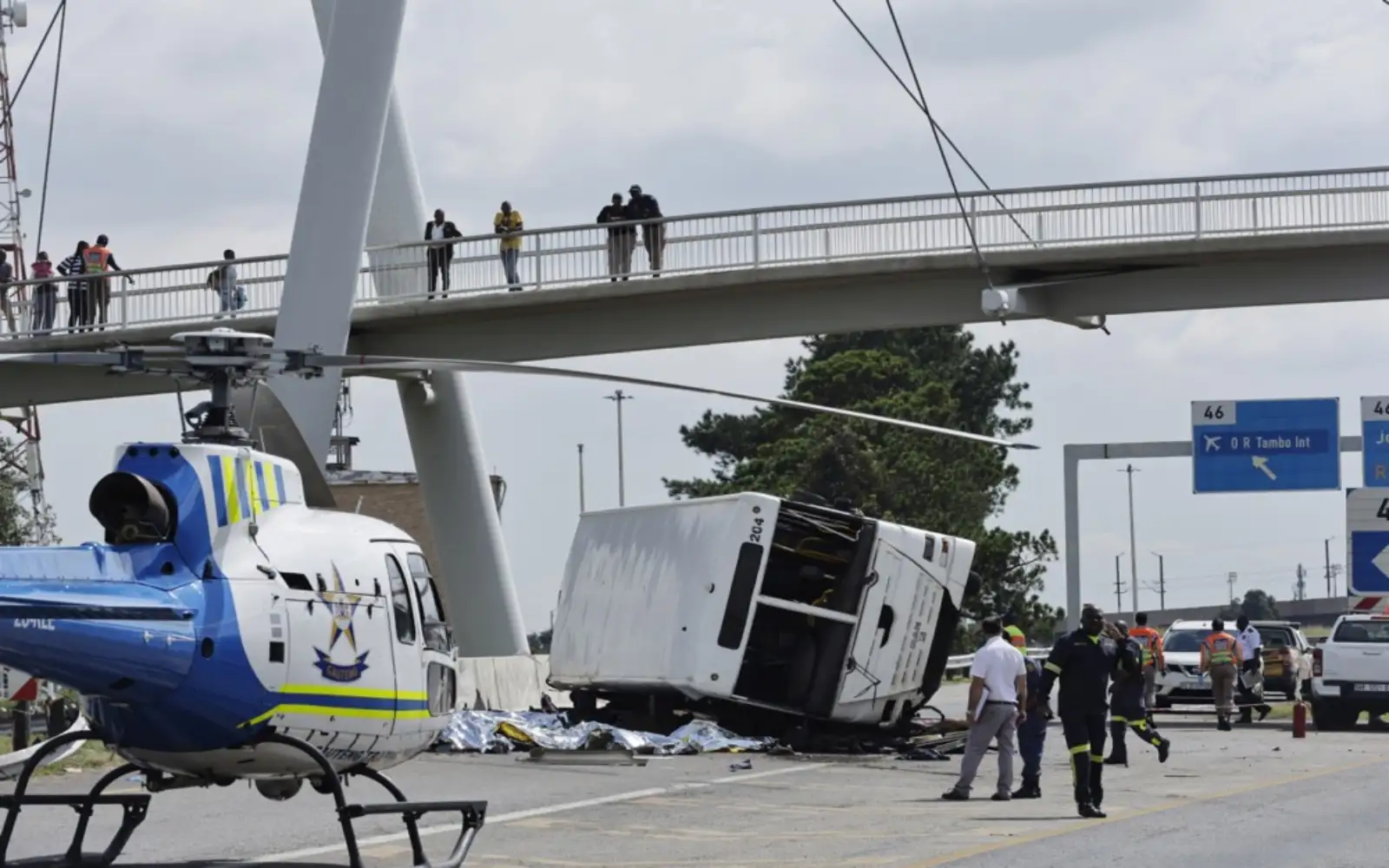In a devastating incident early Tuesday morning, a bus carrying over 50 passengers overturned on a busy road near OR Tambo International Airport, resulting in the tragic loss of at least 12 lives and leaving 45 others injured. The accident, which has shocked the local community and raised fresh concerns about road safety in South Africa, underscores the urgent need for improved traffic regulations and vehicle maintenance standards across the country.
A Scene of Devastation
The catastrophic crash occurred in the bustling environs near Johannesburg’s main airport, a major transit hub known for its advanced road network and heavy daily traffic. According to local authorities, the bus was en route to transport passengers to work when it lost control and overturned on a busy highway. Eyewitnesses reported a chaotic scene as the bus lay on its side, with emergency services rushing to the scene to tend to the wounded and secure the area.
Ekurhuleni city transport official Andile Mngwevu expressed deep sorrow over the tragedy, stating, “This is a disaster; we are at a loss for words.” His remarks capture the shock and dismay felt by officials and residents alike. The accident has not only claimed precious lives but has also disrupted traffic flow and forced authorities to temporarily close the highway leading to the airport—a critical artery for the region.
Immediate Response and Investigation
Local emergency services responded promptly to the distress calls from the accident scene. Paramedics and first responders worked tirelessly amidst the chaos to extricate survivors from the wreckage and transport them to nearby hospitals. While some of the injured are now receiving treatment, the fate of many others remains uncertain as medical teams continue to work through the night.
Authorities have launched an investigation to determine the exact cause of the crash. Preliminary reports indicate that the accident’s origin remains unclear; however, the severity of the incident has prompted a comprehensive inquiry into whether factors such as speeding, driver error, or mechanical failure may have contributed. As investigations continue, the focus remains on gathering all available evidence to prevent similar tragedies in the future.
A Pattern of Road Safety Concerns
This heartbreaking incident is not an isolated occurrence in South Africa. Despite having one of the more advanced road networks on the continent, the nation continues to grapple with alarmingly high road fatality rates. Experts often point to a range of factors—including speeding, reckless driving, poorly maintained vehicles, and the widespread failure to use seat belts—as critical contributors to the recurring road accidents across the country.
Recent incidents have further highlighted the systemic issues facing South Africa’s roads. On Monday, just a day before the bus crash near OR Tambo, a separate collision in Ekurhuleni claimed the lives of four schoolchildren, injuring five others. In that incident, two vehicles collided in an area east of Johannesburg, sending shockwaves through the community and igniting debates over driver accountability and road safety enforcement.
Furthermore, last week, another tragic accident in KwaZulu-Natal claimed the lives of at least nine people, including a four-year-old child. The accident involved an 82-seater bus carrying congregants returning from a church service, which veered into a ditch. The cumulative effect of these incidents has brought renewed scrutiny to the practices and conditions on South African roads.
Underlying Causes: Speed, Recklessness, and Maintenance
The recurring nature of such tragic events points to systemic challenges that extend beyond isolated incidents. Speeding and reckless driving continue to be pervasive issues on South Africa’s highways, often exacerbated by a lack of stringent enforcement and public awareness. Many drivers, in a bid to beat traffic or due to impatience, ignore speed limits and engage in dangerous driving behaviors that put themselves and others at risk.
In addition to driver behavior, the condition of vehicles plays a crucial role in road safety. Poor maintenance and the use of outdated or substandard vehicles can significantly increase the likelihood of mechanical failures, particularly on busy roads and during high-traffic periods. The bus involved in the recent accident is now under intense scrutiny as investigators work to determine if mechanical issues may have contributed to the loss of control.
Another critical factor is the consistent failure to use seat belts. In many cases, the lack of seat belt use has turned otherwise survivable accidents into fatal ones. Despite ongoing campaigns by road safety authorities and non-governmental organizations, many passengers continue to neglect this simple but life-saving precaution.
Government and Community Responses
In the aftermath of the accident, local government officials have pledged to review and strengthen road safety measures. Ekurhuleni city authorities, in particular, have expressed their determination to improve traffic management and enforce stricter regulations to prevent future tragedies. Discussions are already underway regarding the implementation of more rigorous vehicle inspections, increased fines for speeding and reckless driving, and enhanced public awareness campaigns on the importance of seat belt use.
Community leaders and activists have also called for greater accountability from transport companies and drivers. “This tragedy is a wake-up call for all of us,” said one local activist. “We must work together—government, transport operators, and citizens—to ensure that such incidents become a thing of the past. Lives are at stake, and we cannot afford to ignore the warning signs.”
The Human Cost of the Accident
Beyond the statistics and policy discussions lies the human cost of this disaster. Each of the 12 lives lost represents a family shattered by grief and a community forever marked by loss. The injured face long roads to recovery, both physically and emotionally, as they cope with the aftermath of the crash. Families are left with deep scars and a sense of injustice that such tragedies continue to occur despite advancements in technology and infrastructure.
In the immediate wake of the accident, counselors and support services have been mobilized to assist survivors and the bereaved. Community centers and local organizations are offering free counseling sessions to help individuals process their trauma and begin the healing process. These efforts are a crucial component of the broader response, emphasizing that recovery extends far beyond the physical rebuilding of roads and vehicles.
The Broader National Implications
The recent bus crash near Johannesburg’s main airport is symptomatic of a larger national challenge. South Africa’s ongoing struggle with road fatalities is a matter of grave concern, not just for public safety but also for economic development. High rates of road accidents impose significant burdens on the healthcare system, reduce workforce productivity, and strain public resources. Each accident represents not only a personal tragedy but also an economic setback that affects the nation as a whole.
National policymakers are increasingly aware that a comprehensive strategy is needed to tackle the root causes of road accidents. This includes investing in better infrastructure, adopting advanced technologies for traffic management, and improving driver education programs. Moreover, there is a growing call for public-private partnerships to foster innovations in vehicle safety and road design that can prevent accidents before they occur.
A Call to Action for All Stakeholders
In light of these recurring tragedies, it is imperative that all stakeholders come together to address the systemic issues contributing to road accidents in South Africa. The government must lead with decisive action by enacting and enforcing stricter traffic laws and ensuring that road safety measures are not merely symbolic but effectively implemented. Transport companies, too, have a responsibility to ensure that their vehicles are well-maintained and that their drivers are properly trained and monitored.
Citizens also play a critical role. Public awareness campaigns should not only inform drivers about the risks of speeding and reckless behavior but also empower them to demand safer road conditions from their elected representatives. By fostering a culture of safety and accountability, South Africa can begin to turn the tide against the high incidence of road fatalities.
Moving Forward: A Path to Safer Roads
The path to reducing road accidents is multifaceted and requires sustained effort from all quarters. Investment in modern infrastructure, continuous training for drivers, and the adoption of new technologies such as automated traffic monitoring systems are all part of the solution. Additionally, learning from the experiences of other nations with similar challenges can provide valuable insights into best practices that have proven effective in reducing road fatalities.
In the wake of this latest tragedy, there is a renewed sense of urgency to implement these measures. The government’s response, while commendable, must be swift and comprehensive to ensure that no further lives are lost on South African roads. As investigations continue and authorities work to understand the exact causes of the recent bus crash, it is clear that the lessons learned from this incident must translate into meaningful changes in policy and practice.
Conclusion: Honoring Lives Through Action
The devastating bus crash near Johannesburg’s main airport, which claimed the lives of at least 12 individuals and left 45 injured, serves as a stark reminder of the critical need for improved road safety in South Africa. As the community mourns the loss of loved ones and supports those who are injured, the broader challenge of reducing road fatalities looms large. This incident is not just a tragic headline—it is a call to action for government officials, transport companies, and citizens alike.
In the face of such loss, the commitment to preventing future tragedies must be unwavering. By addressing the systemic issues of speeding, reckless driving, vehicle maintenance, and seat belt non-use, South Africa can move towards a future where the roads are safer for everyone. The memory of those lost in this terrible accident must serve as a catalyst for change—a reminder that every life is invaluable, and that concerted, collective action is needed to protect all who travel on the nation’s roads.
As investigations continue and new safety measures are put in place, the hope is that the lessons learned from this incident will ultimately lead to a significant reduction in road accidents. In doing so, the nation will honor the memory of the victims not just through mourning, but through a resolute commitment to making South Africa’s roads safer for future generations.




